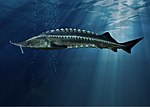Search results
Appearance
The page "Cartilaginous skeleton" does not exist. You can create a draft and submit it for review or request that a redirect be created, but consider checking the search results below to see whether the topic is already covered.
- Chondrichthyes (redirect from Cartilaginous fish)is a class of jawed fish that contains the cartilaginous fish or chondrichthyans, which all have skeletons primarily composed of cartilage. They can be...45 KB (2,440 words) - 15:09, 14 August 2024
- the cartilaginous viscerocranium (i.e., splanchnocranial elements), such as the hyoid bone, are sometimes considered part of the facial skeleton. The...5 KB (421 words) - 00:13, 12 September 2023
- Fish fin (section Cartilaginous fishes)bones; in cartilaginous fish (Chondrichthyes) and jawless fish (Agnatha), fins are fleshy "flippers" supported by a cartilaginous skeleton. Fins at different...89 KB (7,643 words) - 23:55, 14 August 2024
- Osteichthyes (redirect from Comparison of cartilaginous and bony fishes)bony fish had not yet evolved ossification and their skeletons were still mostly cartilaginous, and the main distinguishing feature that set them apart...32 KB (2,186 words) - 21:02, 24 August 2024
- had a bony skeleton and anatomical details associated with cartilaginous and bony fish, demonstrating that the absence of a bony skeleton in Chondrichthyes...29 KB (2,021 words) - 02:52, 26 August 2024
- Acanthodii (category Prehistoric cartilaginous fish)close relation to modern cartilaginous fish can lead them to be considered "stem-sharks". Acanthodians had a cartilaginous skeleton, but their fins had a...18 KB (1,407 words) - 13:10, 24 August 2024
- unique morphological characteristics of lampreys, such as their cartilaginous skeleton, suggest they are the sister taxon (see cladistics) of all living...84 KB (8,924 words) - 21:21, 31 August 2024
- Icosteiformes. The ragfish body is scaleless and limp, because of its cartilaginous skeleton and its flabby muscles. None of the fins have any spines. The dorsal...3 KB (249 words) - 19:09, 20 July 2023
- gland which allows them to attach to objects. The tadpoles have a cartilaginous skeleton and a notochord which eventually develops into a proper spinal cord...17 KB (2,025 words) - 01:30, 27 August 2024
- Sharks (superorder Selachimorpha) are a type of fish with a full cartilaginous skeleton and a highly streamlined body. The earliest known sharks date from...12 KB (1,115 words) - 07:09, 10 March 2024
- paddlefish is a smooth-skinned freshwater fish with an almost entirely cartilaginous skeleton and a paddle-shaped rostrum (snout), which extends nearly one-third...57 KB (5,918 words) - 19:37, 5 July 2024
- Cladoselache (category Late Devonian cartilaginous fish)Cleveland Shale on the south shore of Lake Erie. In addition to the cartilaginous skeleton, the fossils were so well preserved that they included traces of...45 KB (4,687 words) - 09:53, 16 July 2024
- sturgeon, such as an elongated body, heterocercal tail, partially cartilaginous skeleton, naked skin and longitudinal series of scutes. The dorsal fin has...25 KB (2,849 words) - 03:30, 11 September 2024
- as the cartilaginous fishes, which include the sharks, the skeleton is composed entirely of cartilage. The segmental pattern of the skeleton is present...31 KB (3,620 words) - 16:55, 3 August 2024
- other sturgeons, this species is a bottom feeder and has a partly cartilaginous skeleton, an overall streamlined shape, and skin bearing rows of bony plates...25 KB (2,832 words) - 18:19, 8 September 2024
- Splanchnocranium (redirect from Cartilaginous viscerocranium)The splanchnocranium (or visceral skeleton) is the portion of the cranium that is derived from pharyngeal arches. Splanchno indicates to the gut because...2 KB (148 words) - 18:33, 29 October 2023
- the Agnatha class. The Agnatha are ectothermic or cold, with a cartilaginous skeleton, and the heart contains 2 chambers. In modern agnathans, the body...42 KB (2,726 words) - 19:31, 31 August 2024
- Notably, however, the cartilaginous skeleton is not a primitive character, but a derived one; sturgeon ancestors had bony skeletons. They also lack vertebral...57 KB (5,473 words) - 11:19, 17 August 2024
- Chondrichthyes, or the cartilaginous fish. Members of this class have a backbone, gills, no swim bladder, jaws, and a skeleton made of cartilage, a soft...141 KB (10,098 words) - 15:53, 16 July 2023
- SKELETON The bony and cartilaginous skeleton considered, not the notochord.—Nature of the earliest cartilaginous skeleton.—The mesosomatic skeleton of
- almost identical to that of the Megalodon, as sharks have full cartilaginous skeletons. However, there is no evidence, other than its similarity to the
















